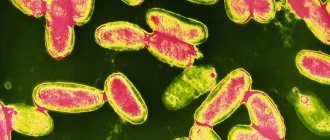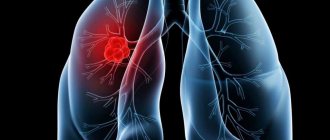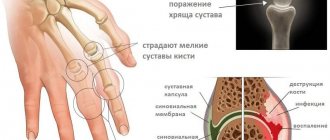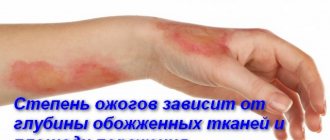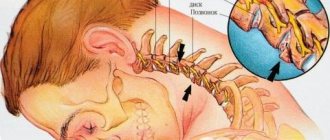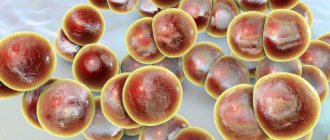Do adults get “stomach flu”? What are the symptoms of rotavirus infection in adults? How to treat it?
Rotavirus infection affects every child aged 6 months to 5 years. But this disease does not belong to the category of children.
Firstly, there are three types of viruses that provoke it.
Secondly, one episode of illness in this case does not mean stable lifelong immunity. “Intestinal flu,” also popularly called rotavirus infection, can also affect adults, although they tolerate it more easily than children. Moreover, due to the similarity of symptoms, they often confuse this disease with an upset stomach or a common ARVI.
How is rotavirus transmitted?
Rotavirus infection in children: treatment at home. Rotavirus, the causative agent of the infection, is a round-shaped virus with a high survivability.
Lifespan of rotavirus outside the human body:
| Habitat | Period |
| Fruits and vegetables | up to 1 month |
| Tap water | 2 months |
| Other items | from 1 week to 1.5 months |
Like most intestinal infections, rotavirus is transmitted from person to person through the digestive system, causing irritation of the mucous membranes, gastroenteritis and severe diarrhea.
Routes of infection with rotavirus infection
Routes of infection with rotavirus include:
- Food. It occurs when eating food with unwashed hands, improperly preparing food, and violating safe food storage methods. In addition, the virus is resistant to low temperatures and can survive for a long period in the refrigerator.
- Water. The presence of rotavirus in water leads to mass infection and epidemics.
- Domestic. It is noted when contacting patients through dirty hands or touching surrounding objects or toys on which the virus lives.
- Airborne. Infection comes from the patient during sneezing and coughing.
Remember! When communicating with patients with rotavirus infection, you should strictly observe the rules of personal hygiene to prevent transmission of infection.
Rotavirus infection occurs mainly in children of primary preschool age. In the period from 0 to 4 years, the disease occurs in a moderate and severe form, in the age range of 5-9 years - in a milder form.
The disease is caused by rotavirus, which in 20-30% of cases causes infectious lesions accompanied by diarrhea in children.
Important! At risk of diagnosing rotavirus infection are children attending children's educational institutions and other groups with a large concentration of children.
Incubation period of rotavirus
Rotavirus infection in children: treatment at home. The incubation period is the time from the moment the rotavirus enters the body until the first symptoms of the disease appear.
In the case of rotavirus infection, this time period is 2 days. This is the time it takes for the virus to develop and reproduce in the human body.
For the onset of the disease, only 1-2 viruses enter the body.
How rotavirus begins
Rotavirus infection begins like a common cold. Children complain of discomfort in the throat, cough, runny nose, headache and general weakness, and redness of the oropharyngeal mucosa is noted.
All age groups of children are characterized by an acute onset of the disease, with an increase in body temperature. At the same time, in younger children, a high body temperature (38-39 degrees, rarely up to 40 degrees) persists for up to 4 days; in children over 4 years old, the temperature lasts for a maximum of 2 days and does not exceed 38.5 degrees.
Intestinal disorders in children under 4 years of age are moderate or severe, lasting from 3 to 5 days, from 4 to 8 years - weak or moderate, lasting up to 3 days.
In younger children, intoxication is more pronounced, lasting from 2 to 4 days; in older children, intoxication of the body is moderate or weak, from 1 to 2 days.
The duration of the disease also varies for different ages. In children 0-4 years old, treatment takes up to 1 week, in children 4-8 years old – up to 5 days.
Rotavirus intestinal infection in adults: signs, symptoms
Rotavirus infection in adults is a disease that is characterized by a bright start. Suddenly, several symptoms appear at once. She has harbingers:
- slight malaise
- headache
- prostration
- decreased ability to work
- loss of appetite
They appear during the so-called prodromal period, a short time gap between the incubation period of the “stomach flu” and the disease itself.
During the prodromal period, a patient with “stomach flu” may experience a headache and general malaise.
IMPORTANT: If the patient himself or the doctor could recognize rotavirus from the listed symptoms even in the prodromal period, treatment would be started immediately, the disease would be mild, and recovery would come quickly. But since the prodromal symptoms of many diseases are very similar, “intestinal flu” is extremely rarely diagnosed before the characteristic clinical picture appears.
Symptoms of rotavirus infection in adults: diarrhea and vomiting.
Symptoms of rotavirus gastroenteritis in adults are divided into three large groups:
- Intestinal syndrome. First, the patient begins to have diarrhea. There are from 3 to 9 episodes per day. The stool is watery, first yellow, then sallow in color. Secondly, the patient feels nauseous. He may vomit several times a day, and in severe cases, after every meal or water. Against the background of the first two symptoms, the patient experiences pain in the epigastric region.
- General intoxication. The consequence of the presence of rotavirus in the body of an adult is an increase in temperature, most often to 38 degrees, sometimes slightly more. The patient is chilling, his head, muscles, and joints hurt. He feels a loss of strength.
- Respiratory syndrome. Its symptoms are not obligatory, and in some patients they do not appear at all. If respiratory syndrome occurs, it can occur either during the prodromal period, or simultaneously with intestinal symptoms, or after them. The patient's throat turns red, itchy and sore, and the mucous membranes swell. A runny nose and cough may appear. There is an increase in cervical lymph nodes. The tongue is covered with a white coating.
Symptom of rotavirus infection in an adult: temperature.
IMPORTANT: Usually, adults tolerate temperatures up to 38 - 38.5 degrees well. You need to try not to knock her down. The fact is that at this temperature the body fights rotavirus and creates unfavorable conditions for it. By the third day of illness, as the virus titer decreases, the temperature will begin to drop on its own.
The appearance of these symptoms is a reason to immediately consult a doctor:
- Rotavirus can cause dehydration. It is absolutely impossible to ignore its symptoms or try to endure the disease on your feet.
- Rotavirus is often confused with other intestinal infections, including bacterial ones, such as salmonellosis. Only a doctor, based on the tests, will be able to make the correct diagnosis and adequately treat the patient.
Symptom of rotavirus infection in an adult: sore throat.
Main symptoms of rotavirus infection
| Sign | Frequent manifestations in % |
| Diarrhea | 100 |
| Vomit | 92-93 |
| Appetite disorders or lack thereof | 80-82 |
| Malaise and general weakness | 91-94 |
The above symptoms are often accompanied by flatulence, accompanied by periodic rumbling, and pain in the abdominal area, which intensifies with palpation.
Vomiting appears on the first day of illness during a period of increased body temperature. For babies under 2 years old, repeated vomiting is typical, 3-7 times a day; for older children, it is a single vomiting; mild nausea may be observed for up to 3 days.
Also, on the very first day of rotavirus infection, involuntary loose stools are observed, which bothers babies for 3-4 days. In babies under 2 years of age, bowel movements are liquid, watery and sometimes foamy, have a strong unpleasant odor, are quite abundant, reaching 15 times a day, in more severe forms of infection - more than 25 times. In children over the age of 2 years, the stool has a mushy appearance, yellow or light brown color, a pungent odor, the frequency of bowel movements is up to 3 times a day, for complex types of rotavirus - up to 5 times.
To diagnose the disease, specialists mainly rely on characteristic symptoms and use ELISA testing. The test involves taking fecal samples from the baby and testing them for the presence of rotavirus.
How does rotavirus infection occur?
In children, infection can occur in kindergarten, school, on the playground, on a walk or in an after-school group.
Parents can protect their child from rotavirus infection by instilling hygiene skills from an early age, strengthening the immune system and eliminating contact with infected children. We must not forget that the virus is invisible, so you can get rotavirus anywhere, so here high-quality prevention can prevent infection.
Sometimes parents don’t even know the symptoms of rotavirus, how many days the disease lasts, what diet to follow and how to treat it.
Vomiting with rotavirus can occur from 2 to 7 times a day
First aid at home
Rotavirus infection in children: treatment at home. The course of the disease depends on the age of the children and the general condition of the body.
Due to frequent vomiting and severe diarrhea, babies experience dehydration due to large losses of water. The state of dehydration is accompanied by dryness of the tongue, lips and skin of babies in general, severe thirst, increased anxiety and general agitation.
Further signs such as lack of appetite, rapid heartbeat and breathing problems are added, and severe apathy and lethargy are noted. In children under 1 year of age, there is a slight retraction of the large fontanel.
In babies, the frequency of urination and the volume of urine per day decreases, which also acquires a pungent odor and a dark tint.
Remember! Babies with low body weight and young children under 3 years of age suffer the most from dehydration.
When identifying the first symptoms of the disease, it is important to correctly provide first aid to the baby at home, before the doctor arrives.
Incubation period of rotavirus
When rotavirus is detected, the incubation period is calculated taking into account the growth of virions in the body - at least 15 hours. Then an acute period begins with a sharp increase in temperature, abdominal cramps, vomiting and watery stools. When rotavirus develops in children who complain that their throat hurts, because of this, due to the etiology of the set of symptoms, intestinal flu is confused with a sore throat. However, the throat may hurt from mechanical damage during sudden strain during gagging. To test for rotavirus, you need to submit urine, feces and vomit for testing.
How to quickly cure a child from rotavirus infection
Treatment of the disease occurs on an outpatient basis, at home. Hospitalization in a hospital is required only in rare, most severe cases.
Complications of infection include:
- acute renal failure;
- development of bacterial pathology;
- association with disorders of the central nervous system.
In the absence of adequate treatment, the baby’s life may even be at risk.
To quickly eliminate the infection and avoid complications, you should stop vomiting, diarrhea, lower the baby’s body temperature, and also remove viruses that have entered the body from the body.
To do this, they adhere to a special diet, use pharmaceutical medications and traditional medicine.
Sorbents
Enterosorbents do not affect the virus itself, however, they remove toxic substances that are released during the life of bacteria. They have a sanitizing, detoxifying and antiallergic effect. The earlier you started taking the drug, the greater the therapeutic effect from it.
Sorbents include:
- Smecta. Use the solution before meals or 2 hours after. For acute diarrhea, the daily dose can be 6 sachets. Duration of treatment up to 7 days;
- Enerosgel. Infants are given half a teaspoon of the product (2.5 g) before meals 6 times a day, children under 5 years old are given half a tablespoon three times a day (maximum one sachet), and children under 14 years old are given a tablespoon three times a day. ;
- Activated carbon. Children are prescribed 4–8 tablets between meals;
- White coal. Children 3–4 years old should take 2 tablets three times a day, children 5–6 years old should take 3 tablets with the same frequency;
- Polyphepan. The dose is calculated according to the scheme 0.5–1 g/kg of weight, this amount should be divided into 3–4 doses. Patients over 7 years of age are told to take a tablespoon of powder or granules up to 4 times daily.
How to provide first aid to a child against rotavirus at home
The main direction of treatment of the disease is to eliminate signs of dehydration and replenish fluid in the body.
How to stop vomiting
To stop vomiting in infants, do not give medications until you consult a doctor.
You can alleviate the condition of newborns by following these recommendations:
- do not place the baby on the tummy, especially after eating;
- The baby should be kept in an upright position for about half an hour after eating;
- Do not overfeed your child if vomiting begins after eating.
Dill water, which you can drink 1 tablespoon every hour, as well as green tea, has a positive effect on vomiting.
It is recommended to use Motilium 20-30 minutes before meals.
Remember! If you vomit blood, you must immediately call an ambulance!
Children over 1 year of age who are vomiting are advised to drink more warm liquids and take one of the anti-intoxication medications - activated charcoal, smecta or others.
To improve the digestion of food, enzymes - Mezim or Creon - are used before each meal.
Fighting dehydration
To replenish fluid in the body, children with rotavirus are given saline solutions, for example, rehydron.
- 1 sachet of rehydron is dissolved in 1 liter of chilled but previously boiled water. After each loose stool or vomiting, the baby should be given 50 ml of the resulting solution to drink.
- For moderate severity of the disease, use 10 ml of rehydron diluted in water per 1 kg of body weight every hour.
- If the condition improves, the volume of the solution is reduced to 5 ml.
If loose stools are repeated 2-3 times a day, the recommended volume of fluid per day should be at least 1 liter. Any permitted drinks or 5% glucose solution are given in small portions every 5-10 minutes.
To replenish fluid levels in the body, you should give your child a water-salt solution, which you can prepare yourself by diluting 1 teaspoon of salt in 1 liter of boiled water. This solution should be given to babies every 30 minutes, 100-150 ml.
In severe forms of infection and severe dehydration, when 10% or more of fluid in the body is lost, children are sent to the hospital for intravenous administration of saline solutions.
Decrease in temperature in a child
Rotavirus is afraid of high temperatures and at the same time reduces its activity, so it is not recommended to take tablets if the mercury column of the thermometer has not risen to 38 degrees Celsius.
If the baby's body temperature rises above 38.5 degrees Celsius during rotavirus infection, the following antipyretics are used:
- Nurofen – 3 times a day, 150-900 ml, depending on age.
- Paracetamol.
- Efferalgan – up to 4 times a day, an hour after meals.
- Cefekon. After stool, rectally, 1-2 suppositories, up to 500 mg per day, depending on weight and age.
Remember! Children are not allowed to take aspirin-based medications to lower their temperature. You should also not use rubbing alcohol-containing liquids.
If the baby is bothered by headaches or pain in the abdominal area, antispasmodics are prescribed, which include Papaverine or No-shpa. These drugs are prescribed based on age, 2-4 tablets per day, 40 mg each.
What medications can a child take (by year)
Approved drugs for the treatment of rotavirus infection according to the age of children:
| A drug | At what age is the drug prescribed? |
| Enterosgel | from birth |
| Polysorb | from birth |
| Polyphepan | from birth |
| Smecta | from birth |
| Activated carbon | from 7 years old |
| Rehydralite | from birth |
| Regidron | from birth |
| Pedialyte | from birth |
| Bifiform Baby | from birth |
| Imodium | from 6 years old |
| Acipol | from 3 months |
To increase immunity and strengthen the body's defenses, children are prescribed Viferon in the form of an ointment, applied to the nasal mucosa up to 4 times a day, and Cycloferon tablets, up to 4 per day, half an hour before meals. The period of admission should be no more than 5 days.
Remember! Rotavirus is transmitted from person to person. A patient with rotavirus infection should be placed in a clean, well-ventilated, isolated room with clean bedding. After each visit, be sure to wash your hands thoroughly.
Preventive measures
Prevention of rotavirus infections is the only means of protection against the virus. Contagious rotavirus infection can be avoided in any setting by following basic hygiene rules and taking additional precautions. Such as:
Avoid crowds of holidaymakers
During the hottest months (August-early September), more people go to holiday destinations. Many adults and children can become carriers of the disease and bring it with them to the resort. You can also become infected through food that has been improperly processed.
Prevention of rotavirus infections: crowds of vacationers should be avoided.
Due to large crowds of people and favorable conditions for the development of the virus, the infection process occurs quickly and affects a large number of children, so you should only vacation with children in large resort centers at the beginning of the holiday season.
Avoid swimming on crowded beaches
The more people on the beach, the greater the likelihood of contracting the virus. It is better to avoid crowded beaches, and it is preferable to choose places on beaches where no more than 20 people swim at the same time. Don’t ignore “wild” beaches or special children’s pools.
Relax away from the bays
In bays, for example, in the city of Tuapse, sea water does not change as quickly as on the coast, so the virus persists there for a long time. And warm standing water creates favorable conditions for its reproduction and rapid spread throughout the bay. It is better to plan a vacation with children away from such places.
Maintain good hygiene
From the first days of rest, you need to monitor your child’s personal hygiene.
Teach your baby:
- drink and eat only from clean, personal containers;
- use clean towels and bed linen (it is better to bring a set from home for the child);
- wash your hands systematically, especially before eating;
- do not put your hands in your mouth, swim only with your mouth closed;
- make sure that the child does not plunge headlong into the water. Your face should always be above the surface of the water.
Choose processed foods and bottled water
It is important to remember that only boiling can completely kill the virus:
- Dishes that within 10-20 minutes. boils are considered safer for baby food, which is why they should be chosen for the children's table.
- It is better to choose fruits that have peel. All possible pathogens can be easily removed along with the peel by peeling it.
- Among drinks, children should choose only those that have been heat-treated. For example, tea, compote. Boiled or bottled water is suitable for drinking. But it is better to avoid drinking milkshakes and freshly squeezed juices.
Get a vaccination
Immunity, which remains for a short time after vaccination against rotavirus, will help prevent infection. For vaccination, 2 vaccines are used: monovalent (Rotarix, RV1) and pentavalent (RotaTek, RV5). In Russia, the pentavalent vaccine is mainly used, which is administered orally. The effectiveness of vaccination against rotavirus is 90%.
Such a vaccine will protect the child’s health from the virus or, in case of infection, will reduce the symptoms of the disease to a minimum. The child may get sick, but the illness will be mild and short-lived, which will not affect the rest at all.
How to treat rotavirus infection: video from a doctor
Removing toxins during illness
To remove rotavirus from the body and the toxins it produces, the following drugs are prescribed:
- Polysorb (up to 2 sachets per day).
- Smecta (up to 4 sachets per day in the first 3 days of illness, on the 4th day and beyond - up to 2 sachets, treatment period - from 5 to 17 days). Add 1 sachet of Smecta to half a glass of boiled water and take it throughout the day.
- Enterosgel (3 times a day, 1 tablespoon, 1 hour before meals, washed down with water).
- Activated carbon (up to 5-6 tablets, depending on age and weight, preschool children usually take 3 tablets 3 times a day).
For infants, methods and doses of sorbents are prescribed by the doctor individually.
Many experts also recommend using the drugs Anaferon and Arbidol to shorten the duration of the disease.
Nutrition: what and when to give your child
When treating rotavirus infection, it is important to exclude all heavy foods and dishes from the baby’s diet in order to maximize the unloading of the intestines.
What not to eat if you have rotavirus infection
- fruits and vegetables due to the high content of plant fiber in the composition;
- carbonated drinks and concentrated juices;
- canned food;
- any flour products, including bread;
- fatty and spicy foods;
- dairy products;
- legumes;
- sweets;
- any types of cabbage;
- spices and salt.
Food should be consumed in small portions, 5-6 times a day, boiled or steamed. Various cereals, soups made from fresh vegetables and berry jelly, teas, and dried fruit compote are allowed.
Important! If the baby is breastfed, preference should be given to formulas with a low lactose content or with its complete absence.
As the baby’s condition improves, you can begin to gradually expand your diet.
During the acute period of the disease, children are recommended to have complete rest and bed rest.
Normalization of digestion
Rotavirus infection in children: treatment at home. After prolonged diarrhea, the intestinal microflora is disrupted. Probiotics are used to restore it.
Means for normalizing the functioning of the digestive system for children include:
- Linex (3 times a day, 1-2 capsules);
- Bifiform;
- Acipol (2-3 times a day, 1 capsule for children under 3 years old, from 3 years old - 4 times a day, 1 capsule);
- Ecofuril;
- Lactofiltrum;
- Bifidumbacterin (3 times a day, 1 capsule);
- Enterofuril;
- Bifiform.
These drugs help neutralize the harmful effects of antibiotics, which are often prescribed for rotavirus infection in children.
Fermented milk products have a positive effect on the state of microflora, but they are allowed to be consumed only after complete recovery.
Remember! The best way for children under 1 year to normalize intestinal function is breast milk.
Folk remedies
Rotavirus infection in children: treatment at home. Among traditional medicine, there are many recipes that can be useful for eliminating the negative symptoms of rotavirus infection in babies.
Teas based on medicinal herbs will help eliminate vomiting and nausea:
- valerian root;
- lemon balm;
- mint;
- chamomile;
- ginger root.
You can read information about the benefits of mint tea HERE
When making a decoction, only one type of herb is allowed to be used; you can optionally add rose hips, linden or a teaspoon of honey to the tea instead of sugar.
To relieve inflammation, disinfect and remove toxins from the body, you can prepare a compote of dried blueberries for your baby.
Fennel will help with flatulence, nausea and tummy pain. To make a healing drink, you will need to add 1 teaspoon of dill to a glass of boiling water and leave the decoction for 1 hour. Children under 2 years old are given 1 tablespoon every 2 hours, and children over 2 years old – half a glass.
To reduce fever and normalize digestion, tea made from raspberry leaves is useful. Pour 1 tablespoon of leaves into a glass of boiling water, leave for 10-20 minutes and consume 2-3 times a day.
Remember! All drinks given to the baby should be warm, so they are better absorbed into the stomach walls.
Prevention of rotavirus in children
Prevention of rotavirus includes good hygiene, such as proper hand washing, especially after using the toilet and before eating. It is necessary to avoid drinking raw water - chlorine cannot completely overcome rotavirus. Heat treatment of products should be sufficient, and washing of fruits and vegetables should be thorough.
If a child with rotavirus is identified in kindergarten or school, he must be isolated and kept at home or undergo treatment in a medical hospital, and allowed back no earlier than a few days after the clinical manifestations of rotavirus infection have disappeared.
Preventive measures also include strengthening the general immune system. In case of illness, a strong immune system will be able to cope with the infection faster and better, which will also avoid complications.
How to treat a child at sea for rotavirus infection
Rotavirus infection in children: treatment at home. Any disease is easier to prevent than to treat.
To reduce the risk of rotavirus infection, the following types of prevention are used:
- Vaccination. Conducted for children under 2 years of age. Vaccines used for vaccinations are Rotatex, Rotarix.
- Compliance with personal hygiene rules - washing hands before eating, after contact with animals, after walking.
- Careful processing of foods before eating, especially vegetables and fruits, their proper preparation and storage.
- Avoid drinking tap water.
After recovery from rotavirus, immunity is formed in the child’s body, but it lasts only for 2 weeks. Therefore, it is recommended to be vaccinated against this infection.
Prevention of rotavirus infections in adults: drugs
Due to the high prevalence of infection and the lack of an effective antiviral drug, nonspecific prevention of rotavirus in adults is difficult. To avoid contracting the “stomach flu”, you should:
- Adhere to the rules of personal hygiene. After visiting the toilet, being in public places, upon returning from the street, you should wash your hands before eating. Food products must be washed and thermally processed according to technology. Boil water.
- Isolate a family member with rotavirus gastroenteritis.
- Strengthen your immune system in every possible way.
- If necessary, take probiotics: Linex, Acipol, Lactiale.
- Consume fermented milk products: yogurt, kefir, narine, others.
Qualified approach to treatment
How to treat rotavirus infection? It's better to ask your doctor about this. Self-medication in this case is unacceptable. This approach to fighting infection can cause serious complications. The consequences of rotavirus infection in this case are difficult to correct.
Symptoms and treatment in adults have a close relationship with each other. Please note that no specific therapy has been developed for this case. Antiviral drugs are not used for rotavirus infection. The main efforts are aimed at combating dehydration. For this, the patient is prescribed rehydration drug therapy.
Diet in the fight against gastroenteritis
Another important point in the fight against the disease is diet for rotavirus infection. to stop eating dairy products during treatment .
What can you eat if you have gastroenteritis? Steamed vegetables and meat, cereals and baked goods in small quantities. It is not recommended to eat green fruits and raw vegetables. This can cause complications in the gastrointestinal tract.
The diet after and during rotavirus infection in adults should be combined with a course of treatment of the digestive organs, using enzyme preparations such as Mezim, Pancreatin, Festal. Prebiotics are prescribed without fail - drugs that include bifidobacteria, lactobacilli and beneficial E. coli.
The diet for rotavirus infection is combined with the fight against dehydration. Otherwise, it will not be possible to eliminate the infectious disease without causing negative consequences. It is also recommended to adhere to a diet after rotavirus infection in adults. Only comprehensive rehabilitation therapy and proper nutrition will help you recover faster after an illness.
Meals for rotavirus infection should be fractional. During an exacerbation, it is recommended to take pureed and gentle food to reduce the likelihood of injury to the intestinal mucosa.
Fighting dehydration
It is recommended to discuss the use of any medications for rotavirus infection with your doctor in advance. Regardless of how long a rotavirus infection lasts, the following measures to eliminate dehydration are required:
- treatment is carried out in a hospital setting;
- A solution of sodium chloride and glucose is administered intravenously;
- drink enough fluid;
- If the temperature rises, use antipyretic tablets.
Often medications are not needed for rotavirus infection. Treatment can be carried out with diet and medications that eliminate the symptoms of the disease. Most often using antidiarrheal and antiemetic drugs.
Rehydration process
To reduce the symptoms of an infectious disease, the patient is prescribed sorbents. Most often, Enterosgel and Smecta are prescribed for this. Glucose and colloidal solutions are administered intravenously only in severe cases.
Diet after rotavirus infection in adults plays a huge role in the process of rehydration. Proper nutrition during the development of rotavirus infection allows you to quickly remove pathogenic microorganisms from the body and restore the acid-base environment.
In order to eliminate dehydration, a rehydration procedure is carried out, which involves the use of drugs such as Regidron and Glucosil. If dehydration is severe, the patient is hospitalized for the purpose of infusion therapy with Ringer, Quartasol and Trisol.
When is antibacterial therapy necessary?
Antibacterial medication is not used for gastroenteritis. Antibiotics are needed only when a bacterial infection occurs. For prolonged diarrhea, medications such as Furazolidone and Enterofuril are used. The use of these medications for rotavirus infection allows you to quickly eliminate the cause of the disease and reduce the severity of symptoms, alleviating the patient’s condition.
Long-term consequences of rotavirus
Rotavirus can have serious long-term consequences. The virus most strongly affects the functioning of the gastrointestinal tract.
One of the serious consequences of rotavirus in children and adults can be a decrease in the production of digestive enzymes.
This leads to slower digestion and poorer absorption of food. The natural acidic environment of the intestines shifts to the alkaline side, which is why beneficial bifidobacteria and lactobacilli die in it.
Their place is taken by pathogenic microflora, which causes fermentation and rotting in the intestines.
Pathogenic bacteria and fungi actively multiply, further impairing the digestion of food and the absorption of nutrients.
The condition when opportunistic bacteria predominate in the intestines is called dysbiosis.
This is not a disease in the full sense of the word, since pathogenic microorganisms simply live on the intestinal walls, without penetrating them or spreading beyond the intestines.
However, indigestion cannot but affect the functioning of all systems and organs that begin to experience a lack of substances.
The immediate consequence of dysbiosis can be inflammation of the intestinal wall or stomach - colitis, enteritis, gastritis.
Especially often, against the background of dysbiosis, a deficiency of B vitamins occurs, some of which are synthesized directly in the intestines.
A lack of B vitamins leads to stomatitis, hair loss, dermatitis, and disorders of the nervous system.
Insomnia, anxiety, and irritability appear. Cyanocobalamin deficiency leads to the gradual development of iron deficiency anemia.
Dysbacteriosis has to be treated long and hard, constantly taking tests and taking prebiotics and probiotics.
However, without treatment of dysbiosis, the health condition will increasingly deteriorate, up to the appearance of a variety of diseases in acute and chronic forms.
Left untreated, rotavirus can lead to the following complications:
- sepsis;
- peritonitis;
- chronic intestinal inflammation;
- gastroduodenitis;
- pancreatitis.
Rotavirus and poisoning - how to distinguish
For an accurate determination, you need to pay attention to the course of the disease. If there is suddenness, the symptoms develop quickly, and they are similar to the state of the immediate environment - there is poisoning. Most likely, there is consumption of spoiled foods. Rotavirus often occurs seasonally, and along with digestive tract upset, the previously described symptoms are observed - coughing, lacrimation, runny nose.
Note! Diarrhea and vomiting can be repeated up to 20 times during the day, which is very dangerous for the child’s life. To replenish lost fluid, you need to drink up to 1 liter of water 5-6 hours before.
If these signs are detected, you must:
- urgently call a doctor;
- give your baby as much fluid as possible;
- use special solutions to restore water balance.
Expert opinion
Sergey Alexandrovich Shkarbuta
Family medicine doctor
The degree of dehydration affects children and adults differently. Due to the low weight, it is enough for a child to lose only 10% of the total volume of fluid in the body, and irreversible processes can occur, including death.
Nutrition of children diagnosed with rotavirus infection
Child nutrition is considered important in the treatment of intestinal flu. Dairy and fermented milk products should be completely excluded from the diet, as they are an ideal environment for the virus to multiply. Fatty meats, fried or spicy foods are also prohibited. The diet of a sick child should contain only boiled or steamed foods: vegetables, low-fat soups, chicken broth, porridge cooked in water: oatmeal, rice, as well as jelly, fruit juice, tea. It is recommended to drink large quantities of non-carbonated mineral water: Borjomi.
With rotavirus infection, the child almost always refuses to eat. Parents should not force him to eat, but fluids should be consumed in sufficient quantities, this will help prevent the development of dehydration. If the child asks to eat, you need to give small portions. Small meals will allow the child’s body to recover faster from illness.
Symptoms
The symptoms of rotavirus infection, although quite pronounced, are often confused with manifestations of classic poisoning, influenza and other diseases.
Signs of pathology are formed as the main pathogenesis of infection develops and have a clear cyclical nature. Regardless of the route of entry of virions, they replicate primarily in the intestine, infecting enterocytes and leading to negative changes in the epithelium of the organ. Diarrhea caused by rotavirus with parallel breakdown of intestinal cells leads to malabsorption, transient deficiency, and the released toxins irritate chloride channels and reduce the activity of disaccharidases in the membrane structures of microvilli, thus disrupting the reabsorption of fluids and activating the secretory reflexes of the enteric nervous system.
Primary manifestations
- Severe vomiting. Sometimes unstoppable;
- High temperature, reaching 40–41 degrees. Doesn't work well with classic NSAIDs;
- Diarrhea. Loose stools are gray-yellow or light in color with a clay-like consistency;
- Frequent urge for little need. Urine is rich or dark in color, sometimes with blood flakes;
- General loss of strength and almost complete loss of appetite;
- Runny nose, pain when swallowing, redness of the throat. Formed in a significant proportion of cases, as a result of which rotavirus infection is often confused with ARVI/influenza at an early stage or with oral poisoning.
After the formation of the above-described symptom complex, the acute phase of the disease continues, lasting on average from 3 days to 1 week. In the absence of qualified first aid and proper supportive drug therapy, a person quickly develops symptoms of secondary problems and complications, in particular:
- Dehydration. Dehydration occurs as a result of rapid loss of large amounts of fluid due to metabolic disorders;
- Enteritis/Gastroenteritis. The formation of an inflammatory process in the stomach and small intestine during rotavirus infection is acute and complements the main clinical picture of the disease;
- Lactase deficiency. The secondary form of deficiency occurs as a consequence of blocking the production of enzymes usually secreted by enterocytes into the intestinal lumen;
- Cardiovascular disorders. They are caused by general intoxication of the body and are manifested by tachycardia, increased blood pressure and other negative reactions.
Routes of transmission of rotavirus
Many people believe that viral infection can only be transmitted through airborne droplets through contact with a sick person. But rotavirus in this regard is more sneaky, since it can wait for its victim on the surface of household items, in water (especially in swimming areas or in sewers), on the surface of the ground and unwashed vegetables or fruits.
In warm weather, rotavirus retains its ability to infect longer. For an infection to develop, a person must swallow the virus, then it will settle on the mucous membrane of the throat or in the digestive tract.
Entry of the virus into the body
The disease usually occurs through contact with a sick person. The causative agents of rotavirus infection are highly contagious. They have only one way of spreading - from an infected person. A huge number of microorganisms are excreted in the patient's feces.
To become infected, it is enough for them to end up on hands, clothes, bed linen, household items, phones, door handles and from there migrate into the mouth, and a limited amount will suffice. There is a version, which has not yet been proven or verified, that the airborne route of infection is also possible.
The appearance of a sick person in the house creates a very high probability of illness for other relatives. Impeccable care and observation of the patient at home does not guarantee the exclusion of a collective outbreak. Those most susceptible to the disease are those in professions that are closely related to communication with a large number of people (salespeople, teachers, catering staff, water utilities). That is why failure to comply with the rules of hygiene and prevention always creates a risk of infection with rotavirus.
In children, infection often occurs in a group of peers - in a preschool or school, during walks or on the playground. Drinking unboiled water and swimming in reservoirs pose a risk. Infection can also occur, at first glance, from a healthy person who is a carrier. Parents are able to protect their baby from a dangerous pathology or reduce its consequences by teaching him basic hygiene skills, strengthening his natural immunity and protecting him from contact with sick people.
What drugs cannot treat rotavirus?
No viral disease should be treated with antibiotic drugs. They are absolutely powerless; on the contrary, they can cause greater damage to the body. Antibacterial agents are a broad-spectrum class. They can destroy not only pathogens, but also destroy the intestinal microflora, which leads to a decrease in immunity and a more rapid spread of viruses.
Note! Taking antibiotics is only indicated if, in addition to an oral infection, a bacterial infection has occurred. But this is possible in rare cases and only after 4-5 days after the onset of the disease.
Therapy and recovery
Parents should understand how to treat rotavirus infection in children. The activity of the causative agent of the disease seriously affects the symptoms and healing of the disease. Usually successful healing can be done at home. Only severe cases that threaten complications require hospitalization. Unqualified outpatient treatment without the intervention of specialists threatens the occurrence of insidious consequences and the risk of death.
Rotavirus infection in children, the symptoms of which are known to parents, occurs in different ways. Her therapy consists of two measures: rehydration (replenishing the lack of fluid) and reducing the activity of the pathogen. Children often need antipyretic drugs; they should be taken only if the temperature rises above 38.5 degrees. Aspirin should absolutely not be used.
The treatment model is determined by the severity of the pathology and the age of the child, but invariably contains antiviral medications and sufficient fluids. It is recommended to prescribe absorbent agents that reduce poisoning of the body.
Outpatient treatment should be carried out under the supervision of a doctor who prescribes drugs with the necessary action:
- antivirus;
- rehydration;
- absorbent;
- antidiarrheal and antibacterial;
- probiotics and prebiotics.
A doctor's recommendations are necessary, since no medications other than absorbents should be taken without a prescription. At the initial stage, it is not necessary to use antidiarrheal medications. Upon completion of this stage, enzyme preparations are prescribed: Pancreatin, Creon.
In the absence of clear data, you should not take antibiotics that have no effect on viruses, but can harm the intestinal microflora. Their appointment is necessary for a more precise diagnosis of the onset of the inflammatory process. The end of the disease cannot be stated depending on the duration of its course; recovery is considered to be the absence of rotavirus in a repeated laboratory analysis. In an infectious diseases hospital, before discharge, in order to exclude the fact that the rotavirus may return again, such an analysis will certainly be done.
The disease is most dangerous in the youngest. The younger the child, the greater the chance of being admitted to hospital. It is not recommended to ignore the referral for hospitalization, since about 400 thousand children die from this disease every year on the planet. Many parents rush to discharge their baby home from the hospital at the first signs of improvement, not realizing that a sick child is contagious from the first days until complete recovery. The optimal length of stay in a hospital is from 4 days to a week, after which a test for the presence of the virus is necessary.
The duration of the disease consists of 3 stages:
- incubation, lasting 5 days;
- acute, lasting 5 days;
- recovery, which takes from 4 to 5 days.
There is no need to stay in the hospital all this time, but the decision about treatment is made not after the child’s well-being improves, but only based on the results of laboratory tests.
Do I need a rotavirus vaccine and when should I do it?
One of the effective preventive measures against rotavirus is vaccination. However, adults and children over 1 year of age are not immunized. Currently, two types of vaccines have undergone clinical trials - Rotarix and RotaTek. They are administered orally (into the mouth) in the form of drops and contain weakened living microorganisms.
In Russia, children are vaccinated against rotavirus according to a schedule of 2, 3 and 4.5 months. This measure allows you to protect the child from the disease over the next 5 years, when the risk of complications caused by infection is especially high.
Rotavirus infection in adults does not require special treatment. Signs of the disease are often mistaken for short-term indigestion. If the disease is severe, accompanied by frequent diarrhea and high fever, you should seek medical help.
Author: Baymurzina Regina
Article design: Mila Friedan
What is rotavirus
Rotaviruses belong to the group of RNA-containing microorganisms; their body has a spherical shape; on its surface there are many protein “hooks”, with the help of which the virus is adsorbed on the surface of the cell and launches its genetic information there. After this, the intracellular parasite uses the host's ribosomes to synthesize the proteins it needs for reproduction.
In the human body, rotavirus most often attacks the cells of the digestive tract; due to a disruption in their functioning, corresponding symptoms arise (stool upset, malaise, nausea, and others).
The body can cope with this virus on its own, as the immune system produces interferons that destroy infected cells. But it may take a lot of time to eliminate the infection, and this will have negative consequences on the person’s condition: a severe weakening of the immune system, deterioration of the general condition, weight loss, so it is worth helping the body in time with medications.
What not to eat
From the diet of not only children, but also adults, it is necessary to remove foods that aggravate diarrhea, nausea, and digestive problems. These include:
- vegetable soups, strong broths;
- fried, spicy, smoked, fatty, canned foods;
- sunflower, olive and other vegetable oils;
- raw frozen, dried mushrooms, fruits and vegetables;
- barley, pearl barley, pea and other types of porridges;
- juices, cocoa, coffee, soda, cocktails, etc.;
- preserves, jams, marmalade, honey;
- meat products – sausages, frankfurters;
- dumplings, dumplings, pasta;
- fatty fish;
- sweets, cakes;
- baked goods, pizza, rye bread.
With rotavirus, the baby may refuse breast milk due to insufficient absorption of milk sugar - lactose. These days you will have to replace it with a special soy mixture or baby kefir for one to two weeks. During this time, the digestibility of lactose will be restored, and the baby will again swallow mother's milk with pleasure.
Features of the course of the disease in adults
In adults, the immune system is stronger, so the symptoms of rotavirus are milder. The better adaptability of the gastrointestinal tract also affects. The high acidity of gastric contents and the active production of class A immunoglobulins help suppress pathogens.
The minimum dose of virions for children is from 10 pcs., and for older people – from 103 pcs. But since this infection is very contagious, if there is at least one carrier in the house, the rest of the family members will also get sick in one form or another.
The disease in adults is often asymptomatic, but the person is contagious all this time. Recovery is faster (in about 5 days), and the number of complications is minimal, in contrast to the high mortality rate recorded among children.
However, there are strains of rotavirus that are also dangerous for adults, especially those with poor health. Thus, rotavirus B (or in other words, rotavirus of adult diarrhea) caused the spread of a serious epidemic among the population of all ages in China and India in 1998.
Where does this infection come from?
Sick people are the main source of pathology, and at the same time, a great danger to others. A large number of pathogens leave the patient’s body with feces, which can live for up to twenty-one days. Particularly dangerous are asymptomatic carriers who spread the infection to others.
The most likely route of transmission of the rotovuris pathogen is through household contact. Less common is airborne infection. Contamination of food and transmission by water through swimming in a river or sea are also likely. Regardless of gender, age and other characteristics, absolutely every person is susceptible to this disease. Therefore, the prevention of rotavirus infections in children and adults is extremely important, which we will discuss in detail in this article.
The causative agent of the infection, as a rule, penetrates the body, reaches the intestines and soon disrupts the functioning of the digestive system. This usually happens within ten to seventy-two hours. Among the first manifestations are:
- Catarrhal manifestation in the form of a person developing a spontaneous cough and an unpleasant sore throat, difficulty breathing and problems with yawning.
- An increase in temperature from thirty-eight degrees to forty.
- The presence of loose stools, vomiting, nausea, pain in the intestines and bloating.
Treatment and prevention of rotavirus intestinal infection in children is of interest to many.
Complications
Treatment in adults is short-lived and almost always results in complete recovery.
Rotavirus enteritis, as a rule, does not lead to complications. Only decompensated metabolic acidosis is possible, after which hemodynamic disorders and renal failure develop.
The main thing is to prevent an increase in temperature, which can damage the cells of the body. Without treatment, severe dehydration occurs, which is difficult to cope with by drinking plenty of fluids. Sometimes only intravenous injections of special compounds under the supervision of a doctor and immediate drug correction help to neutralize complications and avoid death.
Antiviral drugs and immunomodulators
The most important component of therapy for rotavirus infection is antiviral drugs, because the main task is to stop the proliferation of the pathogenic agent. This type of medicine contains different types of interferon, a protein that is produced by the human immune system, but in smaller quantities, which helps eliminate infected cells. The most effective antiviral drugs for infection are:
Immunomodulators are drugs that “stimulate” the immune system, they force it to work more efficiently, produce more of its own interferon and antibodies, so the body fights infection faster. Only a doctor should select immunomodulatory medications, since the choice depends on the general health of the patient and the duration of the infectious period. Popular immunomodulators include:
Prevention
The best way to prevent rotavirus infection is vaccination. Vaccination is included in the list of mandatory in Europe and the USA. In the CIS, vaccination against the disease is a private matter for parents.
As preventive measures, doctors recommend:
- maintain hygiene - teach your child and yourself to wash your hands;
- if you suspect the development of intestinal flu in a family member, try to isolate him from others;
- increase nonspecific immunity.
Teach your child to wash their hands
general description
Rotavirus infection is also defined as RI, rotavirus gastroenteritis, rotavirosis, stomach or intestinal flu. The virus is transmitted primarily through food, that is, through unwashed food, dirty hands, etc.
Thus, infection is possible in a variety of ways and, again, through products with rotavirus (in particular, dairy products should be highlighted here, which are especially susceptible to infection due to the specifics of their production). It is noteworthy that rotaviruses can live even in the refrigerator for a long period of time; chlorination of water does not affect them. Contrary to the generally accepted opinion regarding the effect of holy water on viruses due to its altered structure, it should be emphasized that it does not in any way affect the activity of rotaviruses.
Considering that rotavirus also provokes inflammation in the respiratory tract, its spread occurs in a similar way to the traditional influenza virus, that is, by droplets (coughing, sneezing). The virus penetrates the mucous membrane of the gastrointestinal tract (GIT), with the small intestine being predominantly affected. When the gastrointestinal tract is affected, rotavirus infection causes a disease such as enteritis, which manifests itself in inflammation of the intestinal mucosa, respectively, after which symptoms characteristic of rotavirus infection occur. They are expressed, in particular, in disturbances in the digestion of food, which provokes the development of diarrhea with simultaneous dehydration.
Progress of rotavirus development
Rotavirus infections develop in a special way. The causative agent of the disease, having penetrated inside the human body, attacks the intestinal mucosa, namely epithelial cells, which leads to their death. The resulting defects are filled with defective and immature epithelial cells. This process is fraught with the development of enzymatic deficiency. Such changes are accompanied by impaired breakdown and absorption of carbohydrates, mainly lactose. Next, substances that have not been digested enter the area of the large intestine, which is fraught with the accumulation of a large amount of fluid, which is released from the tissues due to excess. This factor provokes the development of diarrhea, which is accompanied by loss of nutrients in the body and dehydration.
Rotavirus can attach only to mature epithelial villi in the small intestine. The disease progresses until all intestinal cells are replaced by new ones. After the acute process of an infectious disease subsides, the body needs to restore digestive functions.
If treatment for rotavirus infection is not started in a timely manner, bacterial flora can be added. In this case, medications for rotavirus must be combined with antibacterial drugs. When bronchial symptoms appear, we are also talking about complications that are associated with the addition of a secondary infection.
Tests for rotavirus
When making the correct diagnosis, an important point remains the differential diagnosis of rotavirosis from diseases such as balantidiasis, lambiasis, gastrointerstitial forms of salmonellosis, dysentery, intestinal yersiniosis, escherichiosis, and cholera.
For this purpose, a stool test is taken for rotavirus; it is required primarily to exclude more dangerous diseases.
The diagnosis of rotavirus infection is considered confirmed if the pathogen is detected in the patient’s stool. To identify it, an antigen test is performed.
Important: the material for analysis must be delivered to the laboratory within 24 hours after receipt.
Based on the test results, a conclusion is given about the presence or absence of antigen to rotavirus in the patient’s stool. Normally, the result should only be negative.
Pediatrician Dr. Komarovsky talks about the symptoms, methods of diagnosis, treatment and prevention of rotavirus infection in a video review:
Chumachenko Olga, pediatrician
70, total, today
( 166 votes, average: 4.52 out of 5)
What to take for rotavirus infection?
Can a baby have milk?
Related Posts
Prevention of infection
The most reliable means of preventing the spread of viruses and capable of protecting against intestinal flu is specific vaccination. Thanks to vaccination, lasting immunity is developed, eliminating re-infection. For prevention purposes, Rotarix is intended for adults with an effectiveness of 98%. This is a colorless liquid containing a weakened strain of the virus. Hand washing is a non-specific, but no less important measure to protect against stomach flu.
Prevention of rotavirus infections involves isolating the patient, especially from children, and organizing monitoring of persons who have been in contact with the infected person.
With timely treatment, it is possible to avoid complications, the spread of rotavirus infection and fatal consequences.
